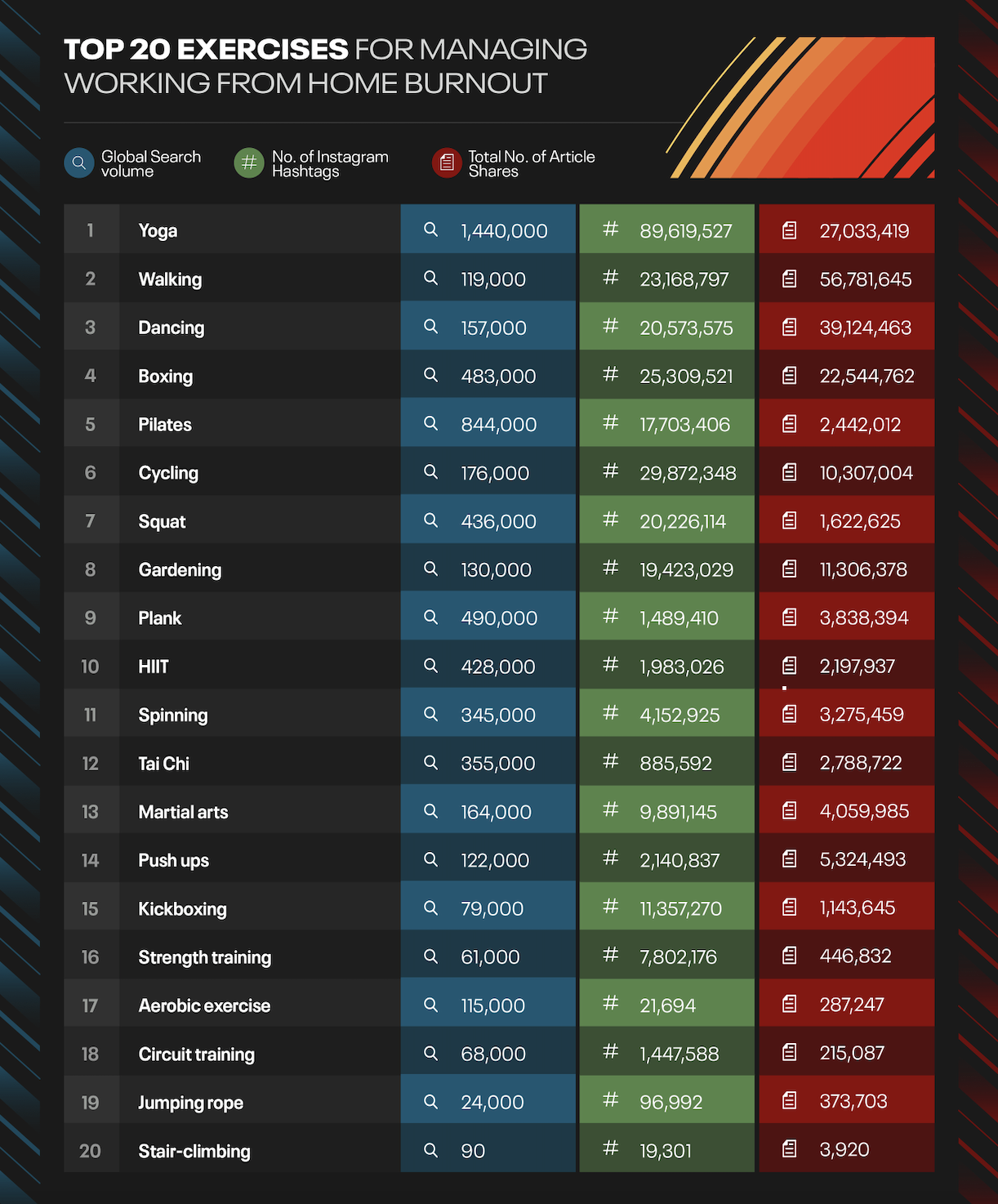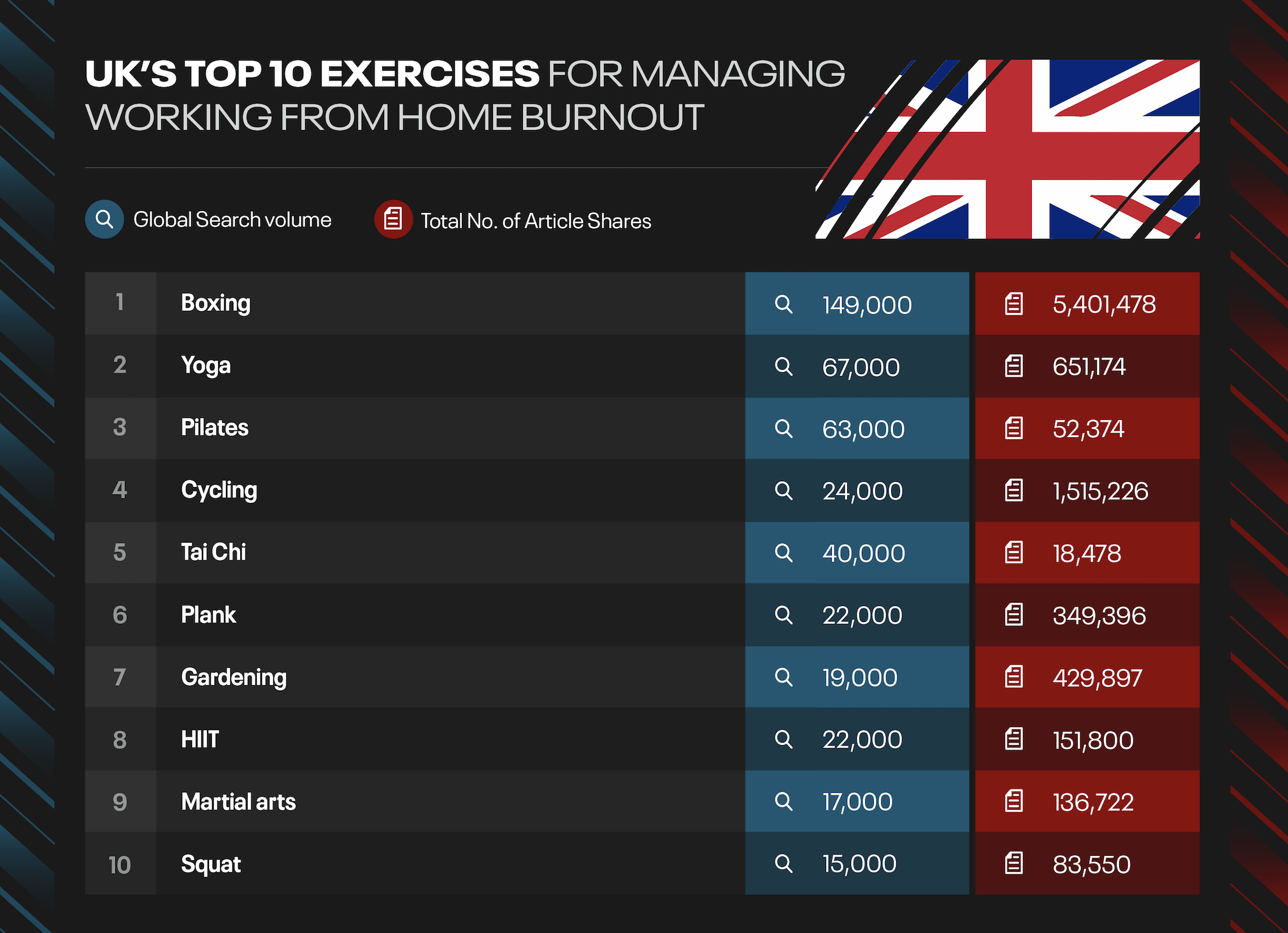TIRED FROM WORKING AT HOME?
Share
Remote working has become the status quo since the outbreak of the Covid-19 pandemic. While working from home certainly has its benefits, it is also accompanied by its own set of challenges including working from home burnout which has been on the rise with an average of 325,000 searches each month globally.
In a new study, Reebok analyses the most popular physical and mental exercises to do while working from home in an effort to combat burnout and improve health and productivity. Partnering with health experts and psychologists, we reveal the most popular exercises for managing burnout that you can do right from home.
TOP 20 EXERCISES FOR MANAGING WORKING FROM HOME BURNOUT

YOGA
According to our study, yoga ranks as the most popular exercise to help ease remote working burnout worldwide, with an average of 1.4 million searches each month, 89.6 million hashtags on instagram and 27 million article shares this year. Yoga is an excellent stress-relief exercise, which involves a series of moving meditations, stationary poses, or postures, which are further combined with deep breathing techniques.
Yoga helps to bring more focus and awareness to our breathing which has both physical and psychological benefits. When we are stressed, we often shorten our breathing. Learning how to regulate your breathing correctly and calmly is a great transferable skill you can incorporate into your everyday life. Practising yoga every day can strengthen your body’s natural relaxation response and “leave you feeling energised, positively charged and happy” states Harvey Lawton, founder of The Movement Blueprint.
Yoga is a key form of exercise for stretching and strengthening the shoulders, back, and abdominals after a day in front of a computer screen. This is necessary as “failing to combat the daily ‘hunch’ poses detrimental effects to our posture” as well increases the “risk of injury and inability to perform.” according to Harvey Lawton.
WALKING
Walking is a simple exercise that helps to boost our mood and relieve stress. With an average of 119,000 searches each month and 56.8 million article shares on the topic globally, it is the second most popular exercise for managing burnout. Walking helps to release tension in the body, both in the neck and in the legs. At the same time, walking can frequently reduce the incidence of stress-related conditions such as cardiovascular disease, high blood pressure and high cholesterol.
Walking helps to stretch and strengthen muscles and is also “beneficial for the hippocampus – which is the part of the brain that acts like a brake on the stress response”, says Ruth Cooper-Dickson, Positive Psychologist.
DANCING
Dancing is a top exercise that can be done in any spacious room you have at home as an instant mood booster and stress reliever. With physical as well as mental benefits, dancing is a great workout that improves grace and agility as it raises your heart rate whilst using your legs actively, helping to strengthen your body and core muscles, simultaneously burning calories and reducing your risk of injury.
Dancing is a great exercise “for activating GABBA (Gamma-aminobutyric acid) — this is an amino acid whose purpose is to calm the brain and act as a fire extinguisher to enable brain cells to suppress their activities.” comments Ruth Cooper-Dickson. “GABBA activation also provides quick and effective stress relief” in an effort to clear your mind after a stressful working day.
BOXING
Boxing requires full concentration which encourages you to switch off from the outside world. Boxing reduces stress by teaching you proper breathing techniques, building confidence, and giving you an instant energy boost.
When punching and engaging in footwork, “areas of the brain involved in complex skill learning and peripheral vision light up”, comments Danny Greaves, Confidence Coach and Physiotherapist. Your brain increases the production of endorphins, which are the neurotransmitters that create the feel-good thoughts and feelings we get from exercise. Punching also helps to relieve muscle tension and even improve your confidence, making you more capable to deal with stressful or challenging situations.
PILATES
Similar to Yoga, Pilates is a series of controlled movements and mat exercises which build your strength, flexibility, and endurance. It can also significantly improve your posture and muscle tone as well as balance and aid long term joint mobility. Pilates has the dual effect of boosting our mood while bolstering our resilience against stressors.
Pilates has an average of 844,000 searches each month, 17,703,406 instagram hashtags and 2,442,012 article shares making it a top exercise to add to a more rigorous exercise programme. Lee Chambers MSc MBPsS, Environmental Psychologist and Wellbeing Consultant comments it “also increases our blood flow and cognitive functioning, allowing us to work with increased focus and clarity, increasing our productivity.”
BOXING IS THE MOST POPULAR EXERCISE FOR DEALING WITH WORKING FROM HOME BURNOUT IN THE UK
 With 149,000 searches each month and a staggering 5,401,478 article shares, boxing is the most popular exercise for managing work related stress in the UK followed by yoga and pilates. These versatile exercises can be done from anywhere in your home making them the perfect workout for a mid day boost!
With 149,000 searches each month and a staggering 5,401,478 article shares, boxing is the most popular exercise for managing work related stress in the UK followed by yoga and pilates. These versatile exercises can be done from anywhere in your home making them the perfect workout for a mid day boost!
Working from home will inadvertently mean “less frequent movement” comments Harvey Lawton, founder of The Movement Blueprint “so making the effort to unravel our body and step away from the desk is key to keeping our joints healthy and our movement pain-free.
HOW TO IDENTIFY PHYSICAL BURNOUT WHEN WORKING FROM HOME
Burnout is our body’s reaction to a prolonged state of stress which often surfaces with feelings of fatigue, detachment, a lack of motivation and a negative or cynical outlook on work.
According to Ruth Cooper Dickson, Positive Psychology Practitioner, burnout manifests itself in three ways.
- Feelings of low energy and exhaustion
- Withdrawal and disengagement from work itself
- Reduced professional self-efficacy
In home office environments, burnout is especially rampant as we struggle to separate work from home which often leads to a poor work-life balance. According to our study, the UK is the most burnt-out country of 2020 with google search interest increasing to 69% compared to pre Covid-19.
Exercise is one of the top methods of dealing with burnout while working from home. Joe Mitton, founder of Mittfit reveals that it is essential “for releasing dopamine and serotonin which both help in mood and sleep” and reduce feelings of stress.
You garner the majority of these benefits with short periods of exercise each day. Lee Chambers MSc MBPsS, Environmental Psychologist and Wellbeing Consultant states that “finding an exercise that you enjoy is vital, as this helps you remain consistent in ensuring you take the breaks and stay active daily.
Whether that is walking around the block, dancing in your living room, yoga in the kitchen or a bodyweight circuit in the bedroom, the considerable benefits of exercise on your mental health, especially over the darker, colder months, should be utilised to ensure you feel fortified for the challenging times we face.”
Feeling motivated to work out right now? Discover the Home Workout Essentials by Reebok.















FOLLOW BESTFIT